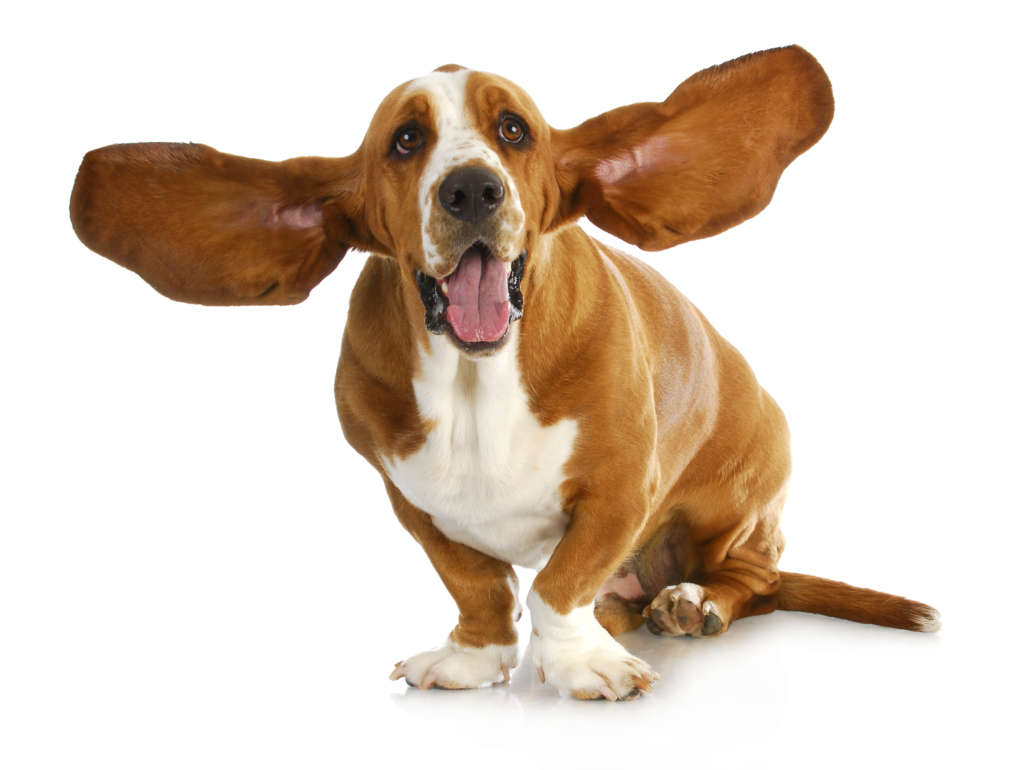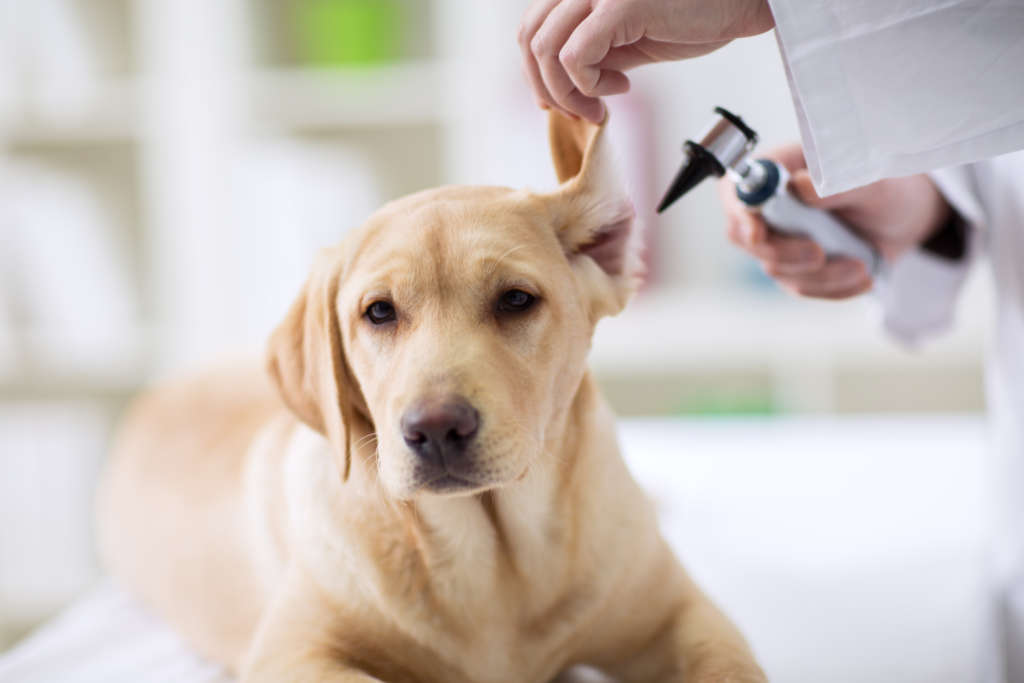Dog ears: they’re a big part of what makes every cuddly pup so adorable. But that big, floppy cuteness can be a source of infection if not properly treated. If your dog’s incessant head shaking, ear scratching, jingling collar tags, or… let’s call it “special” ear odor has you concerned, we get it. Let’s break down ear structure, the common causes of irritation, and the do’s and don’ts of ear care.


What Can Cause Ear Issues in Dogs?
Like in people, dogs have an inner, middle and outer ear. The eardrum is between the outer and middle ear. However, dogs have a large, L-shaped outer ear with those adorably expressive ears landing on top of their heads (instead of on the side of the head like us). In dogs, the large outer ear is where most problems that cause ear irritation occur. While some lucky dogs will go their whole lives without ear issues, some dogs are repeat offenders because of their conformation (the way their body is built), environment, or combination of multiple factors.
Here is a list of factors the increase the likelihood of ear issues1:
- Breed
- Hair in ear canal
- Floppy ears
- Narrow ear canals
- Swimming
- Excessive ear care
- Humidity
- Allergies
What are Some Common Causes of the Dreaded Head-Shaking?
Ear Mites
Ear mites (otodectes cynotis) are parasites that live in the ear canal. Sometimes, they can even be found on the surrounding skin – yuck! This infestation is common in certain geographical regions, or if a dog has been around another infected individual (dog or cat). Ear mites can be prevented with some preventative medications, but not all. If you are in an area where these are common, or your dog is regularly in a group setting (daycare, boarding, dog parks) consider using a flea-and-tick or heartworm preventative that also covers ear mites and save yourself the hassle. If you have multiple pets in your home, all pets will need treatment at the same time1.


Foreign Bodies
Foreign bodies are non-living debris that gets in the ears, causing irritation and providing a place for ear infections to occur. In pets, plant material (grass, for example) is a likely culprit. If you have small children around, small toy pieces are a possibility as well. The L-shape of dog ear canals means it’s not possible to see the whole ear canal without an ear scope – and someone well-trained in how to use it! Just because you can’t see something does not mean that there is nothing in there.
Masses
Masses refer to tissue growth that is not normal. This does not necessarily mean cancer. Cysts and chronic irritation that causes permanent changes to skin thickness can also be referred to as a mass. Similar to foreign bodies, masses cause irritation and can interfere with effective treatment. If a mass is the cause of your pets issue, your veterinarian will help guide you based on what type of mass is causing the issue.
Ear infections
Ear infections are caused by overgrowth of bacteria or yeast, often as a result of the ear health already being off-balance. The imbalance could be caused by any of the issues or risk factors discussed above. Once the bacterial overgrowth has occurred, medication is usually required to (1) get the infection under control, and (2) fix or prevent what allowed it to occur in the first place. Most ear infections in dogs are in the external ear canal, but not all. Issues affecting the middle and inner ear, while uncommon, can become serious very quickly, with long term consequences to your pet’s health if not handled correctly1.
What Should You Do if Your Dog Has Ear Issues?
If you are concerned something is going on in your dog’s ears, please have them seen by your veterinarian before starting any treatment. Some medications and cleaners can only be used if the eardrum is intact. As we discussed above, most ear infections in dogs are in the external ear, but not always, and they’re usually caused by something else. Treating the cause of an ear infection is needed to prevent them from coming back. The location of the issue is important to know before starting treatment, because the best option depends on where and what is causing it.


Pro Tips:
- Do not clean your pets ears before your pet’s appointment! Your vet will need to see the issue (and, yes, the goo) to help you treat the problem.
- If you have ear products at home, bring them with you to your veterinarian. Depending on the issue, you may be able to use what you already have.
In general, ear infections are not an emergency. Save yourself and your pocketbook and schedule an appointment with your regular veterinarian.
Exceptions requiring immediate treatment include:
- Bleeding from the ear (it would be a LOT- not from a small scratch)
- Walking in circles in one direction
- Inability to walk or balance
- Symptoms unrelated to ear infections (lethargy, not eating, etc.) in addition to ear concerns
Ear Care Do’s
- Keep your pet’s ears clean and dry
- Check your dog’s ears once a week and clean only if needed using a dog-specific ear flush
- If you notice bright pink/red ears, check them regularly over 24 hours and have them seen by your veterinarian at the next available appointment
- Consider if parasite prevention that covers ear mites is appropriate for your dog
Ear Care Don’ts
- Do not pluck your dog’s ear hairs (if you have an -oodle, trimming that hair is much better!)
- Never put anything into your dog’s ears (like a q-tip or tweezers) unless directed by a veterinarian.
- Do not clean your pets ears more than once weekly for maintenance unless directed by your veterinarian
- Never use vinegar or hydrogen peroxide to clean your dog’s ears
- Never start or stop ear medication unless directed to do so by your veterinarian
Colleen Ferriman, DVM, is a canine and feline health, wellness, and illness management advocate. She has a combined 10 years of experience in clinical medicine, education, and educational content development. Colleen graduated from Colorado State University as a Doctor of Veterinary Medicine, has worked as a general practitioner, and has contributed to the development of veterinary educational tools. She is also a member of the American Veterinary Medical Association and American Academy of Veterinary Pharmacology and Therapeutics.
Sources:
1 E. Cote. “Hyperadrenocorticism”. Clinical Veterinary Advisor Dogs and Cats, 2nd ed. St. Louis, Elsevier Mosby 2011 pp. 804-810.






